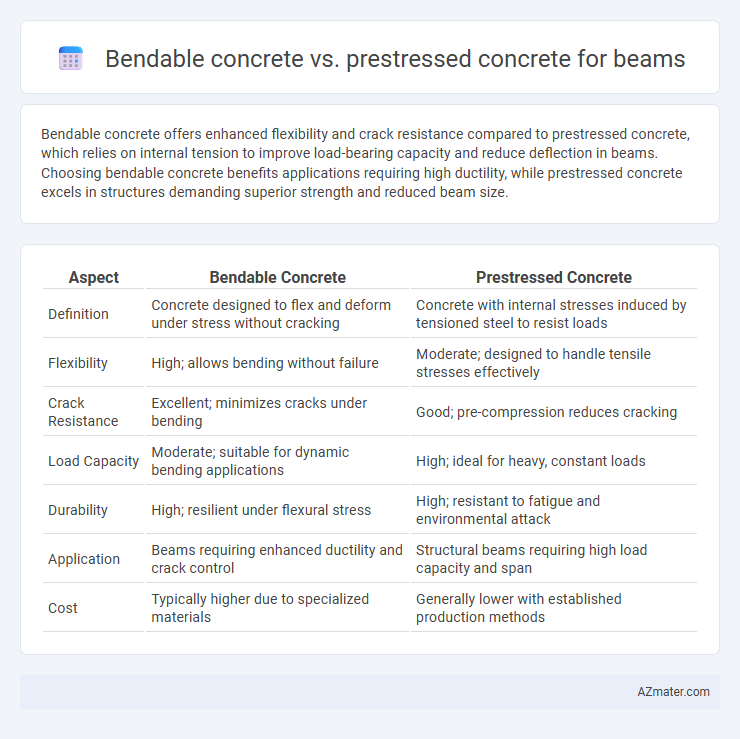Bendable concrete offers enhanced flexibility and crack resistance compared to prestressed concrete, which relies on internal tension to improve load-bearing capacity and reduce deflection in beams. Choosing bendable concrete benefits applications requiring high ductility, while prestressed concrete excels in structures demanding superior strength and reduced beam size.
Table of Comparison
| Aspect | Bendable Concrete | Prestressed Concrete |
|---|---|---|
| Definition | Concrete designed to flex and deform under stress without cracking | Concrete with internal stresses induced by tensioned steel to resist loads |
| Flexibility | High; allows bending without failure | Moderate; designed to handle tensile stresses effectively |
| Crack Resistance | Excellent; minimizes cracks under bending | Good; pre-compression reduces cracking |
| Load Capacity | Moderate; suitable for dynamic bending applications | High; ideal for heavy, constant loads |
| Durability | High; resilient under flexural stress | High; resistant to fatigue and environmental attack |
| Application | Beams requiring enhanced ductility and crack control | Structural beams requiring high load capacity and span |
| Cost | Typically higher due to specialized materials | Generally lower with established production methods |
Introduction to Modern Concrete Technologies
Bendable concrete, also known as engineered cementitious composite, exhibits high tensile ductility and crack control, making it ideal for applications requiring enhanced flexibility in beams. Prestressed concrete incorporates pre-tensioned or post-tensioned steel tendons to improve load-bearing capacity and control deflections in beams under heavy service loads. Both technologies represent advancements in modern concrete, optimizing structural performance through innovative material properties and reinforcement methods.
What is Bendable Concrete?
Bendable concrete, also known as engineered cementitious composite (ECC), is a high-performance material designed to withstand tensile strains up to 3-5%, significantly higher than conventional concrete, allowing beams to flex and bend without cracking. Unlike prestressed concrete, which relies on tensile reinforcement through steel tendons tensioned before or after casting, bendable concrete incorporates fine synthetic fibers that distribute stress and prevent crack formation. This strain-hardening behavior enhances durability and fatigue resistance in beam applications where flexibility and crack control are critical.
Understanding Prestressed Concrete
Prestressed concrete beams use high-tensile steel tendons tensioned before or after casting to counteract tensile stresses, enhancing load-bearing capacity and reducing deflection. Unlike bendable concrete, which improves flexibility through fiber reinforcement, prestressed concrete relies on inducing compressive stress to control cracking and improve durability. This method optimizes structural performance in bridges, buildings, and long-span applications by increasing strength and service life.
Key Differences: Bendable vs Prestressed Concrete
Bendable concrete offers enhanced tensile strain capacity, allowing beams to undergo large deformations without cracking compared to traditional prestressed concrete, which relies on high compressive stress to counteract tensile forces. Unlike prestressed beams that use steel tendons tensioned before or after casting to improve load-bearing capacity, bendable concrete employs engineered fiber reinforcement to achieve ductility and flexibility. The key difference lies in bendable concrete's ability to sustain significant bending and deformation with reduced brittleness, whereas prestressed concrete primarily increases beam strength and stiffness through induced compressive stresses.
Strength and Flexibility Comparison
Bendable concrete beams exhibit enhanced flexibility due to their engineered microstructure, allowing them to sustain higher strains without cracking, which significantly improves durability under dynamic loading. In contrast, prestressed concrete beams achieve superior strength through induced compressive stresses that counteract tensile forces, enabling longer spans and higher load capacity with reduced cross-sectional dimensions. While prestressed concrete excels in ultimate load-bearing capacity, bendable concrete offers improved damage tolerance and crack control, making it ideal for applications requiring resilience against bending and deformation.
Durability and Crack Resistance
Bendable concrete exhibits superior crack resistance due to its high tensile strain capacity, enabling beams to withstand larger deformations without significant damage. Prestressed concrete beams enhance durability by introducing compressive stresses that counteract tensile loads, reducing the likelihood of initial cracking. Both materials improve structural longevity, but bendable concrete offers more extensive crack control under flexural stress, while prestressed concrete focuses on minimizing crack widths through internal force balancing.
Cost Analysis and Material Efficiency
Bendable concrete beams, such as those using engineered cementitious composites (ECC), offer enhanced crack control with lower reinforcement costs compared to prestressed concrete beams, leading to potential savings in long-term maintenance expenses. Prestressed concrete provides high load-bearing capacity and reduced beam depth, optimizing material use for large spans but incurs higher initial costs due to specialized prestressing equipment and skilled labor requirements. Evaluating cost analysis and material efficiency reveals that bendable concrete improves ductility and reduces repair needs, while prestressed concrete maximizes structural performance but demands more upfront investment.
Applications in Beam Construction
Bendable concrete, known for its high tensile strain capacity, is ideal for beams in seismic zones and structures requiring enhanced crack resistance and durability. Prestressed concrete beams, commonly used in bridges and high-load bearing applications, utilize tensioned steel tendons to achieve superior strength and reduced deflection. The choice between bendable and prestressed concrete depends on project-specific load demands, environmental conditions, and longevity requirements in beam construction.
Environmental and Sustainability Considerations
Bendable concrete beams reduce cracking and extend service life, decreasing maintenance and repair needs, thus lowering environmental impact compared to traditional materials. Prestressed concrete beams require high energy input for steel tensioning and often involve heavier material use, increasing embodied carbon. Choosing bendable concrete supports sustainability by enhancing durability and reducing resource consumption over the beam's lifecycle.
Choosing the Right Concrete for Your Project
Bendable concrete offers high tensile strength and enhanced crack resistance, making it ideal for beams exposed to dynamic loads or requiring improved durability without extensive reinforcement. Prestressed concrete provides superior load-carrying capacity and deflection control by pre-tensioning the steel reinforcement, suitable for long-span beams subjected to heavy loads. Selecting the right concrete depends on project requirements such as load conditions, beam span, durability needs, and budget constraints.

Infographic: Bendable concrete vs Prestressed concrete for Beam
 azmater.com
azmater.com